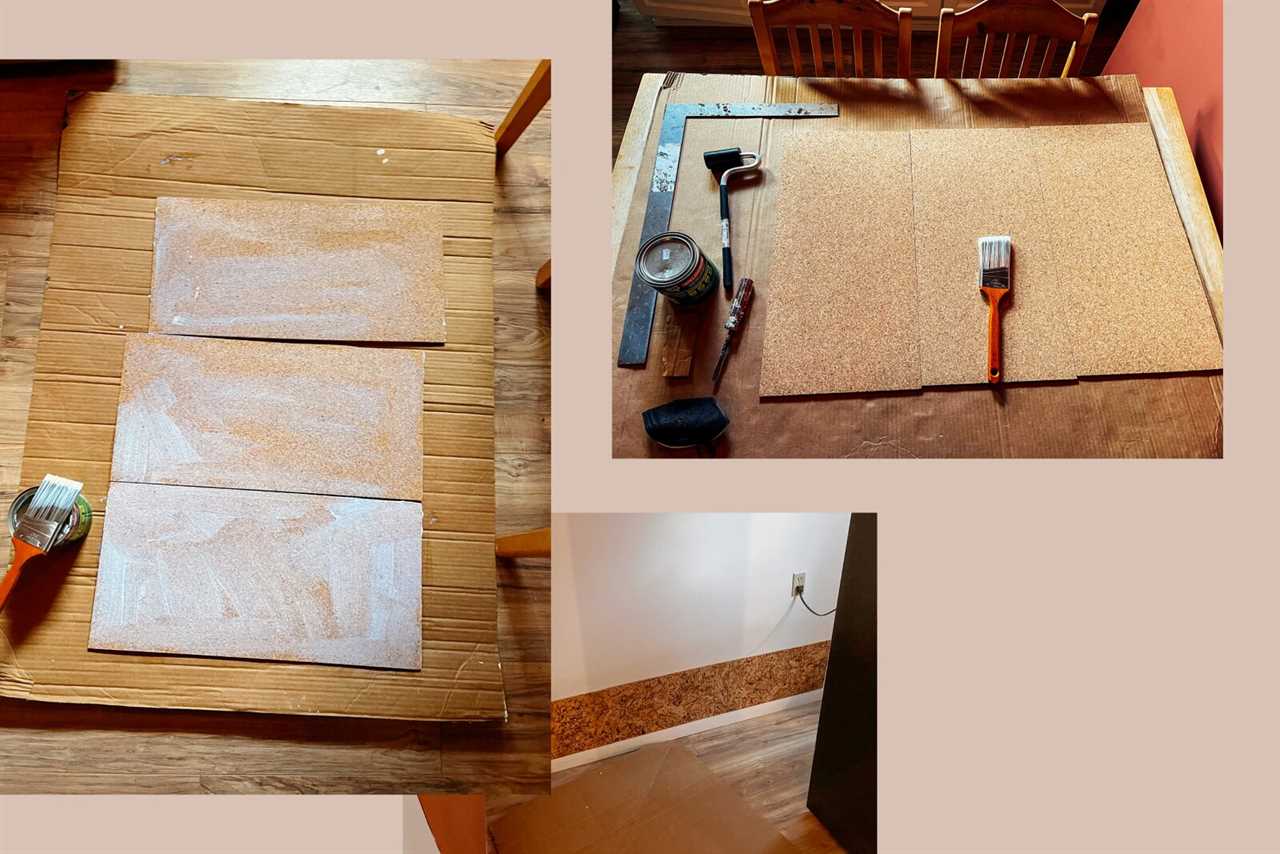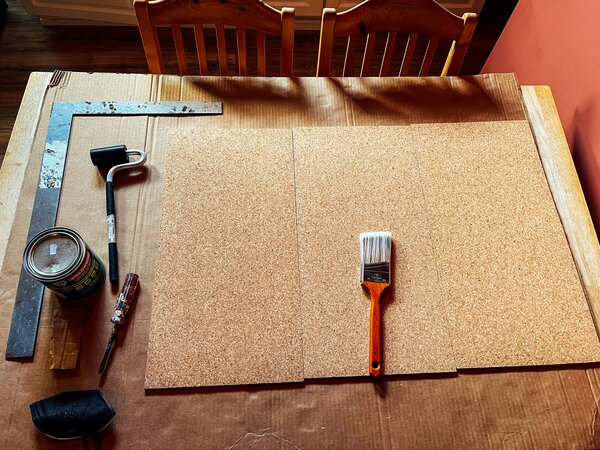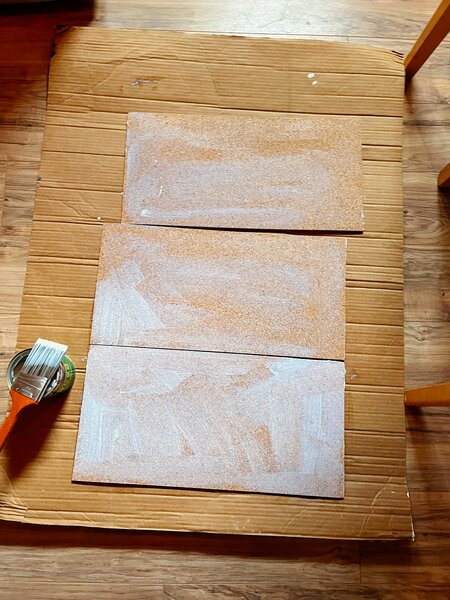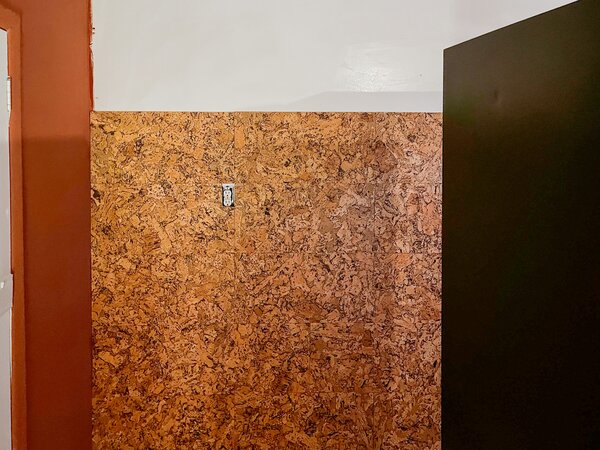Throwing a trendy material into the mix of my basement-bar makeover was a risky choice—but in the end, it paid off.

This is Making a Bar, a four-part DIY series in which our intrepid Executive Editor turns her under-utilized basement into the hopefully chic home hangout of her dreams.
When we last left things, I had successfully painted the walls that needed it in the future bar space in my quasi-basement slash downstairs. But this strange room required more than a coat of paint, no matter how magical paint proponents claim it to be—it needed something specifically to conceal, or at least draw the eye away from, the back, windowed wall, which had a large sheet-rocked bump-out on the top concealing pipes and who knows what else. It needed texture, I realized, and that’s when it hit me: cork!
I’d been a fan of a number of recent projects we’d covered at Dwell using the material, even, creatively, outside, particularly because of its sustainability factor. Often only associated with literal cork boards seen in classrooms or tacky Italian restaurants, it can have a slightly updated midcentury vibe to it when applied correctly. The more I dug into it, the more it seemed like cork tile would be relatively easy to apply and the answer to the leaning-into-a-cave-aesthetic dive bar experience I was looking for.
After doing some research, I discovered that one of the leading brands in this market is CorkHouse, a part of the Jelinek Cork Group. (Per their website, which boasts a fascinating history: "Today it is one of the oldest continually active cork companies in the world. It remains a privately owned, fifth generation family run company headquartered in Canada with subsidiary warehousing, office, and/or production facilities in various countries around the world.") I reached out to the company about doing a test of their wares, and soon I was being sent a couple boxes of cork tile, ready to figure out if my vision was just that.
Installation
But before that, I did some perusing of their website to make sure I was choosing the right material for this project. In the home improvement category, CorkHouse offers floor coverings, wall coverings, cork rolls and sheets, and cork specifically designed for insulation. I decided to go with the basic Tackboard cork tile in Desert (with standard backing, which means it didn’t have any adhesive on it already). I had to do some careful measuring—not my strong suit, so I did it a few times to be sure. I thankfully also had some assistance on this part; I sent over photos of the wall—which would be partially covered by the aforementioned window and the room’s cabinets—to a helpful customer service representative, who suggested they send me about 15 percent overage so I wouldn’t run out. This came to about 115 sq feet of tile (this particular choice runs at $15 per 2 square foot of tile, which isn’t exactly cheap, but makes sense given the material and how it’s sourced).
As I waited for the cork to ship, I did a little more research into the application process. The company recommends you have the following for installation: a water-based contact cement, a brush, a J-roller (sort of like a rolling pin but for pressing the tiles into the wall and making sure the glue really adheres), and a sharp utility knife for cutting the cork tiles to size. An important note: you have to let the tiles get adjusted to the climate of the room for three days before installing them. Cork breathes!
Then I watched their installation video several times, and made my partner read the instructions and watch the video as well. (Note that while you could certainly do a project like this alone, particularly if you were working with a smaller space than I was, it went much faster with two hands.)

Starting was daunting as it always is. I would suggest ventilating your room as much as possible, and wearing a heavy-duty mask to avoid the fumes from the glue. We began with applying the adhesive to the back of a few tiles, the wall where they were going to be applied, and waiting a few minutes until they got tacky—this will go faster if you do have the windows open. Then we pressed the tiles up against the wall, while also rolling over them with the J-roller. The corners have a tendency to peel up the most, so be sure to really hit those. This wall, as stated before, was not the most straightforward of projects, and we had to make a lot of weird cutouts—windows, outlets, etc—that I thankfully left for my partner to measure out while I was in charge of gluing. We fell into a rhythm, and finished most of the wall in a few hours, before taking a pause to continue the next day. I couldn’t believe how quickly it went.


See the full story on Dwell.com: I Tried Cork Tiles to Achieve Warm Texture in a Dark Space
Read More
By: Kate Dries
Title: I Tried Cork Tiles to Achieve Warm Texture in a Dark Space
Sourced From: www.dwell.com/article/cork-house-tile-review-92722fcc
Published Date: Thu, 09 May 2024 16:18:58 GMT
Did you miss our previous article...
https://trendinginbusiness.business/real-estate/5-fun-facts-about-buffalo-ny-how-well-do-you-know-your-city
.png)





